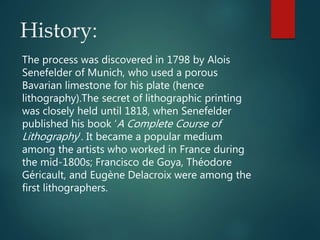Lithography
- 1. LITHOGRAPHY
- 2. Definition: Lithography is a greek word where lithos means 'stone' and graphein means 'to write‘. It is a method for printing using a stone (lithographic limestone) or a metal plate with a completely smooth surface.
- 3. History: The process was discovered in 1798 by Alois Senefelder of Munich, who used a porous Bavarian limestone for his plate (hence lithography).The secret of lithographic printing was closely held until 1818, when Senefelder published his book ‘A Complete Course of Lithography’. It became a popular medium among the artists who worked in France during the mid-1800s; Francisco de Goya, Théodore Géricault, and Eugène Delacroix were among the first lithographers.
- 4. What is Lithography?? Lithography is an "offset" printing technique. Ink is not applied directly from the printing plate (or cylinder) to the substrate as it is in gravure, flexography and letterpress. Ink is applied to the printing plate to form the image (such as text or artwork to be printed) and then transferred to a rubber blanket. The image on the blanket is then transferred to the substrate (typically paper or paperboard) to produce the printed product.
- 5. The principle behind it.. Lithography is based on the principal that oil and water do not mix (hydrophilic and hydrophobic process). Lithographic plates undergo chemical treatment that render the image area of the plate oleophilic and therefore ink- receptive and the non-image area hydrophilic. During printing, fountain (dampening) solution, which consists primarily of water with small quantities of isopropyl alcohol and other additives to lower surface tension and control pH, is first applied in a thin layer to the printing plate and migrates to the hydrophilic non-image areas of the printing plate. Ink is then applied to the plate and migrates to the oleophilic image areas. Since the ink and water essentially do not mix, the fountain solution prevents ink from migrating to the non-image areas of the plate.
- 6. “Printing Process” Lithography uses a planographic plate, a type of plate on which the image areas are neither raised nor indented (depressed) in relation to the non- image areas. Instead the image and non-image areas, both on essentially the same plane of the printing plate, are defined by deferring physiochemical properties. Traditionally, isopropyl alcohol was used to control surface tension in the fountain solution, but in recent years it’s use has been reduced, the reason for this shift is due to the VOC emissions attributed to the evaporation of isopropyl alcohol and the level of environmental regulation this leads to.
- 8. Applications: •Early Lithography Lithography was originally devised as an inexpensive alternative to movable-type printing. The first attempts at lithographic printing used a single ink. As the process developed, printers in Eurorimenting with multiple-color printing. Lithography was initially used to print simple images and text. •Chromolithography As the lithographic process evolved, increasingly complex designs and color palettes could be transferred to paper stock. Godefroy Engelmann introduced the chromolithographic process in 1837. Through the use of individual printing stones or metal plates dedicated to the transfer of a single color, elaborate images could be produced. As this process was more expensive than the basic lithographic technique, it was used primarily for large-scale works and gifts.
- 9. •Quantity Production Arabic speaking countries were among the first to utilize lithography for bulk printing. Religious texts such as the Quran could not be properly printed with movable typesetting due to the linked nature of letters in the Arabic alphabet. The lithographic process solved this problem for printers in the East. In 1903, Ira Washington Rubel developed the offset lithographic technique that became the standard printing method for newspapers and periodicals. •Art Work Beginning in the 1820s, artists attempted to incorporate the lithographic process into their works. Towards the end of the 19th century, the increasing affordability of chromolithography allowed many visual artists to produce colored prints. Celebrated artists who utilized these techniques include Pablo Picasso, M.C. Escher and Jasper Johns.
- 11. Charles Marion Russell Carson’s Men, 1913.
- 12. Alfred Concanen Isabella Grace on a Balcony. The Talisman (Tales of the Crusaders)
- 13. Video clipping of the process
- 14. LITHOGRAPHY IN INDIA From the 19th century to the first decade of the 20th, India was at the hub of a great expansion in lithographic printing. Hundreds of lithographic printing houses flourished in India, and although books in Persian were only a part of their production, it was there that the largest number of Persian lithographed books was published. Mir Ḥasan Rażawi, Munshi Nawal Kishor, Malek-al- Kottāb, Mirzā Moḥammad, Akbar Padamsee, Kamal Mitra and Anil Bihari were some of the lithographers.
- 15. The first lithographed books can be dated to the third decade of the 19th century: 1824 in Benares, 1826 in Agra and Calcutta where the Asiatic lithographic publishing house was at work. Up to the middle of the fourth decade of the 19th century, lithography was still a matter of individual experiments. Lithographed books in Persian started to come out regularly from the mid-40s of the 19th century in Bombay, Lucknow, Cawnpore, Calcutta, and Madras, and from the late 1840s in Agra, Lahore, and Delhi.
- 16. Works from the lithographic printing house of Mir Ḥasan Rażawi
- 18. Anil Bihar’s works Sadhna,1995. Agantuk,1995
- 19. Thank you



















